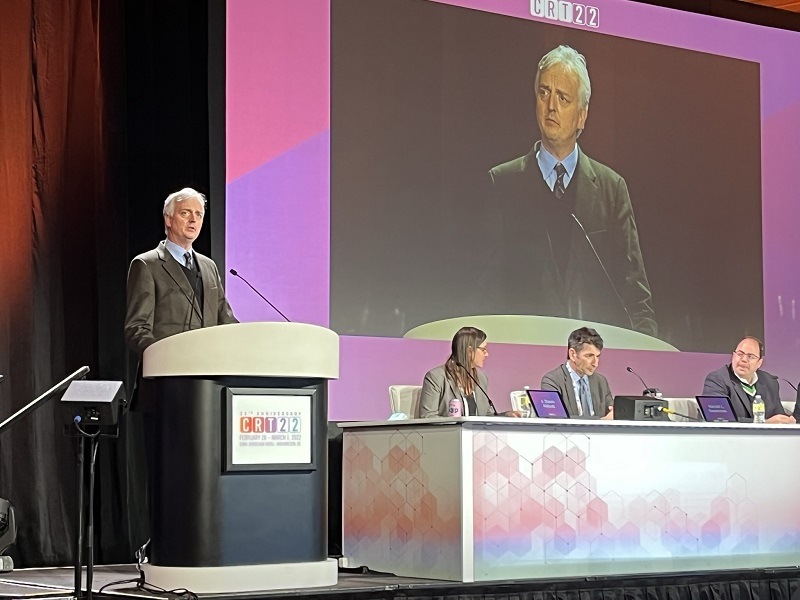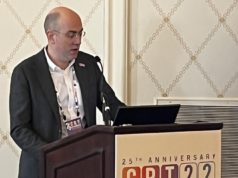
Final five-year results from the BIOFLOW-V trial, presented during a late-breaking trial session at CRT 2022 (27 February–1 March, Washington DC, USA), affirm the durability of longer-term outcomes with the ultrathin Orsiro coronary drug-eluting stent (DES) compared to Xience (Abbott).
BIOFLOW-V US principal investigator, David Kandzari (Piedmont Heart Institute, Atlanta, USA) who presented the results at CRT 2022, told attendees that through the five-year follow up, significant differences in the individual outcomes of target vessel myocardial infarction (MI) and late stent thrombosis persisted, favouring treatment with Orsiro over Xience.
However, Kandzari also revealed that though previously identified significant differences in target lesion failure (TLF) and target lesion revascularisation (TLR) seen at one-, two- and three-year follow-up remained numerically lower, they were no longer statistically significant, indicating some catch-up over the longer term between the two devices.
New iterative coronary stent development has included new metal alloys, changes in stent architecture and bioresorbable polymers, Kandzari told the CRT audience, noting that both individual trials and meta analyses have demonstrated significant improvements in both safety and efficacy outcomes with ultra-thin strut drug-eluting stents compared with alternative designs.
The trial randomised 1,334 patients undergoing elective percutaneous coronary intervention in a 2:1 fashion between the Orsiro versus the Xience stent in 13 countries in North America, Europe, Israel, New Zealand and Asia.
The primary endpoint was target lesion failure, defined as a composite of cardiovascular death, target vessel related myocardial infarction and clinically driven target lesion revascularisation at one-year, but with prespecified planned follow up through five years.
Previously the trial has demonstrated superiority of the Orsiro stent at one-, two- and three-year follow-up with regard to the primary endpoint, a composite of TLF, as well as target vessel MI. Further, at two and three year follow up, superiority with the Orsiro compared to the Xience stent was identified with regard to TLR.
Detailing the results, Kandzari commented that completeness of follow-up was identical for both groups, with a total of 884 patients initially randomised to the Orsiro group, 807 (91.3%) of whom were still active at five-year follow-up, and 450 were enrolled in the Xience group, with 411 (91.3%) active at the five-year timepoint. The baseline characteristics, and angiographic and procedural characteristics were broadly similar between the two groups.
“As we have previously reported at one-, two- and three-year follow-up, divergent rates that significantly favour the Orsiro stent were observed through three years of follow up,” he said.
“Now, today through five years of follow-up in a Kaplan Maier analysis, the rate of target lesion failure is 15.3% for the Xience cohort, and 12.3% for the Orsiro cohort, an approximate 3% absolute difference, but with a p-value of 0.11.”
With regard to individual components of the composite endpoint, there were no significant differences in cardiovascular death, but there remained a >4% absolute reduction in the occurrence of target vessel myocardial infarction, significantly favouring treatment with the Orsiro stent, a difference of 7.3% vs. 11.5% with a p-value of 0.02, Kandzari added.
Though ischaemia-driven TLR did differ at two and three years of follow-up between the two groups, Kandzari explained that this no longer remained statistically significant at five years, despite being numerically lower with the Orsiro cohort, a difference of 6.3% vs. 8.2% (p=0.22).
Significant differences in target vessel MI were maintained through five years of follow up, driven both by a difference of periprocedural MI, but also by differences in spontaneous MI through longitudinal follow up and a significant difference between the two cohorts with regard to the occurrence of Q-wave MI, according to Kandzari.
No significant differences in TLR were identified at five-years, although rates were similar at one year and began to diverge after two years, achieving statistical significance at two and three years, he explained. “Although the differences remained numerically lower through five years, they no longer remained significantly different,” he said.
Alternatively, stent thrombosis did remain significantly different through five years, favouring the Orsiro stent, particularly with regard to both late and very late stent thrombosis, Kandzari noted. The occurrence of very late state thrombosis was 0.1% and for the Orsiro cohort and 1% for the Xience cohort with a p-value of 0.047. The composite of late and very late stent thrombosis was also significantly lower favouring the Orsiro stent.
In his concluding remarks, Kandzari said: “Altogether, these findings confirm the durability of longer term comparative outcomes with an ultra-thin strut bioresorbable polymer sirolimus-eluting stent, demonstrating continued differences in late ischaemic events.”












